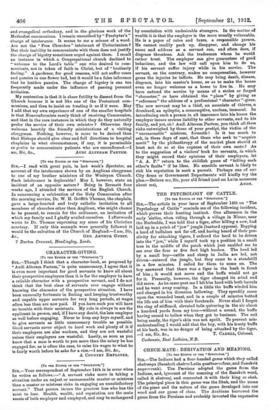THE PSYCHOLOGY OF CATTLE.
[TO THE EDITOR OF THE "SPECTATOR."] Sin,—The article in your issue of September 14th on " The Psychology of Cattle " reminds me of the following incident, which proves their hunting inetinct. One afternoon in the early 'sixties, when riding through a village in Nimar, near the Nerbudda, I was told that a, tiger, after killing a cow, bad laid up in a patch of "jow" jungle (bastard cypress). Espying a herd of buffaloes not far off, and having heard of their pro- clivity for attacking tigers, I ordered the herd to be driven into the " jow," while I myself took up a position in a small tree in the middle of the patch which just enabled me to see over the four or five feet high bushes. The herd led by a small boy—cattle and sheep in India are led, not driven—entered the jungle, but they came to a standstill in a few minutes. I called for them to come on. The boy answered that there was a tiger in the bush in front of him ; it would not move and the buffs would not go for it. Presently, however, the tiger changed its mind and did move. As he came past me I hit him hard with both barrels and he went away roaring. In a little the buffs winded him and charged in his direction bellowing. They speedily came upon the wounded beast, and in a couple of minutes butted the life out of him with their foreheads. Never shall I forget the ring of stiffened, elevated tails quivering in the air about a hundred yards from my tree—without a sound, the buffs having ceased to bellow when they got to business. The soil being sandy, the tiger's skin was not spoilt. To prevent mis- understanding I would add that the boy, with his trusty buffs at his back, was in no danger of being attacked by the tiger.
—I am, Sir, &c., T. CADELL, Colonel. Cockenzie, East Lothian, N.B.










































 Previous page
Previous page